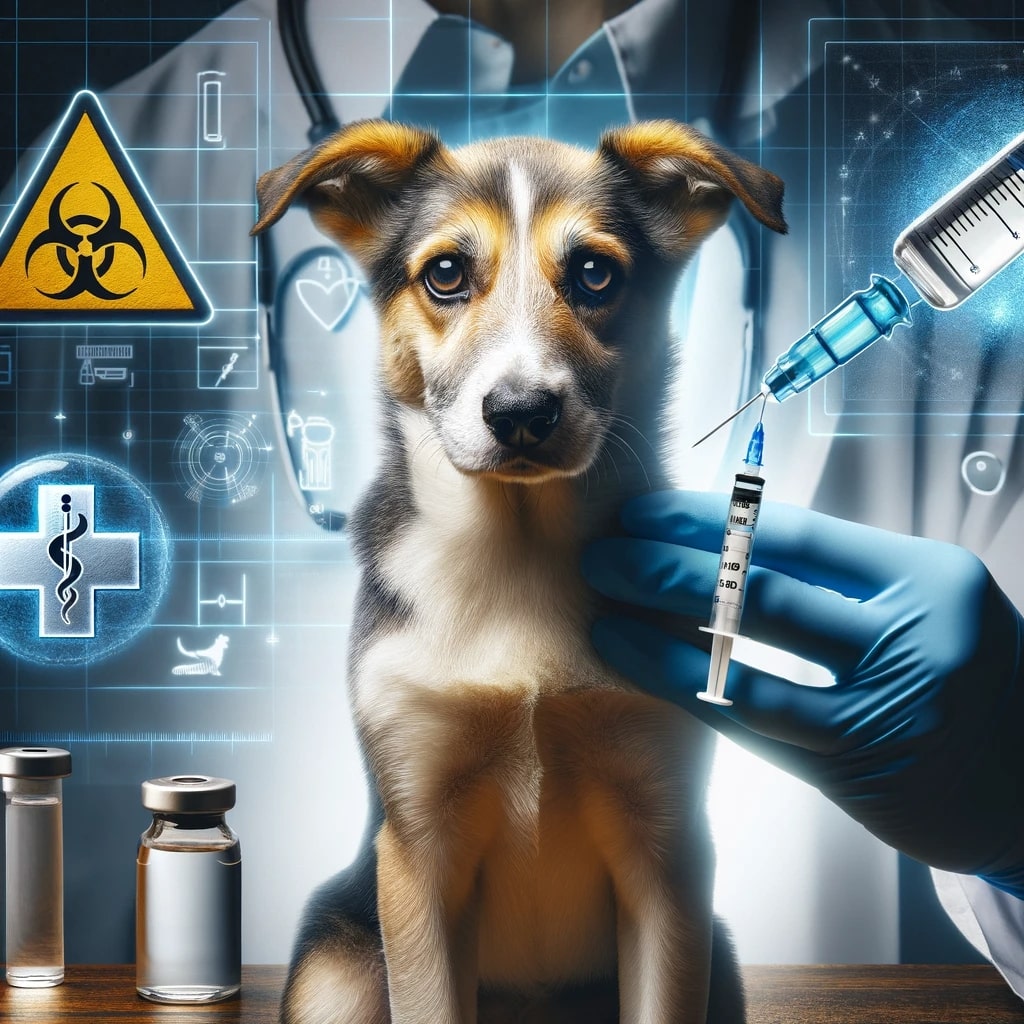Brucellosis is a bacterial infection that can significantly affect the health of dogs. As a dog owner or a pet enthusiast, it’s crucial to understand this disease, its symptoms, transmission, and treatments. This comprehensive guide is designed to answer the most frequently asked questions about brucellosis in dogs, providing you with the knowledge you need to keep your furry friend healthy and safe.
What is Brucellosis and How Does it Affect Dogs?
Brucellosis is a bacterial infection caused by the genus Brucella. In dogs, the most common strain is Brucella canis. This disease primarily affects the reproductive systems of both male and female dogs, but it can also impact other organ systems.
The Bacterial Infection:
- Causative Agent: Brucellosis in dogs is mainly caused by Brucella canis.
- Transmission: It’s typically spread through direct contact with infected bodily fluids, often during mating, or through contaminated objects.
- Zoonotic Potential: Rarely, it can be transmitted to humans, especially those with weak immune systems.
Symptoms in Dogs:
- Reproductive Issues: Infertility, miscarriages, and stillbirths are common in females. Males may suffer from scrotal inflammation and infertility.
- General Symptoms: Lethargy, weight loss, and lack of appetite.
- Other Symptoms: Swollen lymph nodes, behavioral changes, and intermittent fever.
Diagnosis and Treatment:
- Diagnosis: Blood tests, cultures, and serology tests are commonly used.
- Treatment: Antibiotics are the primary treatment, but the infection can be challenging to eradicate completely.
Prevention and Control:
- Testing: Regular screening of breeding dogs.
- Hygiene: Good hygiene practices in kennels and homes.
- Avoidance of Stray Animals: Reducing contact with stray or unknown dogs.
How is Brucellosis Diagnosed in Dogs?
The diagnosis of brucellosis in dogs involves several steps and tests to confirm the presence of Brucella canis bacteria.
Initial Evaluation:
- Clinical History: Vets will consider symptoms and breeding history.
- Physical Examination: Checking for signs like lymph node enlargement and reproductive abnormalities.
Laboratory Tests:
- Blood Tests: Complete blood count (CBC) and biochemistry profile.
- Serology Tests: Rapid Slide Agglutination Test (RSAT) initially, followed by more specific tests like Agar Gel Immunodiffusion (AGID) or Polymerase Chain Reaction (PCR) for confirmation.
- Culture Tests: Culturing of bacteria from blood, bone marrow, or reproductive tissues.
Imaging:
- Ultrasound: For assessing the reproductive system in both males and females.
- X-rays: To detect any secondary effects on bones or organs.
Interpretation of Results:
- Positive Diagnosis: Confirmed usually with a combination of serological and PCR tests.
- False Positives/Negatives: Further tests or repeated testing may be required in some cases.
Post-Diagnosis Steps:
- Informing Authorities: In some regions, brucellosis is a reportable disease.
- Treatment Plan: Setting up a long-term antibiotic treatment plan.
- Management of Breeding Animals: Infected dogs should be removed from breeding programs.
What are the Treatment Options for Brucellosis in Dogs?
Treating brucellosis in dogs is challenging and requires a multifaceted approach, focusing on both eliminating the infection and managing symptoms.
Antibiotic Therapy:
- Primary Antibiotics: Tetracycline and Streptomycin are commonly used.
- Treatment Duration: Long-term treatment, often for several weeks to months.
- Monitoring: Regular follow-up tests to monitor the effectiveness.
Supportive Care:
- Nutritional Support: Ensuring a balanced diet to support the immune system.
- Symptomatic Treatment: Managing symptoms like fever or pain.
Spaying or Neutering:
- Preventing Spread: Spaying or neutering infected dogs is often recommended to prevent transmission through breeding.
Alternative Therapies:
- Immunomodulators: In some cases, to strengthen the immune response.
- Herbal Remedies: Consultation with a vet is essential before trying any alternative therapies.
Challenges in Treatment:
- Resistance and Relapse: The possibility of bacteria becoming resistant to antibiotics or infection relapsing.
- Long-term Management: Some dogs may require lifelong management.
Can Brucellosis in Dogs be Cured Completely?
The possibility of completely curing brucellosis in dogs is complex and depends on various factors. The disease can be challenging to eliminate entirely due to its ability to hide within cells and evade the immune system.
Challenges in Complete Eradication:
- Intracellular Nature of Bacteria: Brucella canis can reside inside cells, making it difficult for antibiotics to reach and eradicate them.
- Persistence of Symptoms: Even after treatment, some dogs may continue to show symptoms or shed bacteria.
Treatment Success Rates:
- Varying Outcomes: Some dogs respond well to treatment, while others may not.
- Long-Term Antibiotics: Extended courses of antibiotics may be required to achieve negative test results.
Monitoring and Follow-Up:
- Regular Testing: Periodic testing to monitor the bacterial load.
- Assessing Relapse: Watching for signs of relapse even after treatment.
The Role of Spaying/Neutering:
- Preventing Transmission: Neutering infected dogs is critical to prevent spreading the disease through breeding.
- Reducing Hormone Influence: Hormones can affect the course of the disease, so spaying/neutering can be beneficial.
Managing Chronic Cases:
- Lifelong Management: In some cases, lifelong management with periodic treatments may be necessary.
- Quality of Life Considerations: Balancing treatment with the overall well-being of the dog.
How is Brucellosis Transmitted Among Dogs?
Understanding the transmission of brucellosis is crucial for prevention and control measures. The primary mode of transmission in dogs is through direct contact with infected bodily fluids.
Direct Contact Transmission:
- Reproductive Fluids: The most common route is through mating.
- Birthing and Miscarriage Materials: Contact with these materials can spread the infection.
Indirect Transmission:
- Contaminated Objects: Sharing bowls, bedding, or toys with infected dogs.
- Human Handling: Transmission through human handlers is rare but possible if precautions aren’t taken.
Vertical Transmission:
- From Mother to Puppies: Infected mothers can transmit the bacteria to their offspring.
Environmental Factors:
- Kennel Conditions: Overcrowded or unsanitary conditions can facilitate the spread.
- Wildlife Reservoirs: In some regions, wildlife can act as reservoirs of the disease.
Zoonotic Potential:
- Risk to Humans: While rare, the disease can be transmitted to humans, particularly those with weakened immune systems.
What are the Symptoms of Brucellosis in Dogs?
Recognizing the symptoms of brucellosis is essential for early detection and treatment. The symptoms can vary and may be subtle or nonspecific.
Reproductive Symptoms:
- Females: Miscarriages, stillbirths, or infertility.
- Males: Swollen testicles, infertility, or inflammation of the prostate.
General Health Symptoms:
- Lethargy and Weakness: Decreased energy levels.
- Weight Loss: Often accompanied by a lack of appetite.
- Fever: Intermittent fever that may not be persistent.
Other Symptoms:
- Back Pain: Due to infection of the intervertebral discs.
- Eye Infections: Uveitis or other eye-related issues.
- Behavioral Changes: Due to discomfort or pain.
Symptom Variability:
- Asymptomatic Cases: Some dogs may not show any symptoms but still carry the disease.
- Chronic vs. Acute Presentation: Symptoms can vary in intensity and duration.
Are Certain Dog Breeds More Susceptible to Brucellosis?
While brucellosis can affect any dog, there’s no conclusive evidence to suggest that specific breeds are more susceptible. The risk factors are more related to behavior and environment rather than breed.
Factors Influencing Susceptibility:
- Exposure to Infected Dogs: Dogs in breeding kennels or those exposed to stray dogs are at higher risk.
- Age and Sex: Sexually mature dogs are at a higher risk due to the mode of transmission.
Breed Considerations:
- Genetic Factors: There is no known genetic predisposition in any breed.
- Behavioral Traits: Breeds with certain behavioral traits may have different exposure risks.
Importance of Screening in Breeding:
- Regular Testing: Essential for all breeding dogs, regardless of breed.
- Health Certificates: Ensuring breeding dogs are certified free of brucellosis.
Can Brucellosis in Dogs Affect Human Health?
The zoonotic potential of brucellosis in dogs is a concern, especially for individuals with compromised immune systems
or those in close contact with infected animals. However, the transmission of Brucella canis to humans is considered rare.
Understanding Zoonotic Risk:
- Rare Transmission: Human cases of Brucella canis are uncommon, but not impossible.
- High-Risk Groups: People with weakened immune systems, pregnant women, and those working closely with dogs (veterinarians, kennel workers) are at a higher risk.
Symptoms in Humans:
- Flu-Like Symptoms: Fever, fatigue, and muscle pain.
- Long-Term Complications: In rare cases, it can lead to more serious conditions like endocarditis.
Preventive Measures:
- Good Hygiene: Regular hand washing and use of protective gear when handling infected dogs.
- Awareness and Education: Understanding the risks and symptoms of brucellosis.
Diagnosis and Treatment in Humans:
- Diagnosis: Blood tests and cultures to detect the presence of Brucella bacteria.
- Treatment: Antibiotics, similar to the treatment in dogs.
Reporting and Monitoring:
- Report to Health Authorities: In some regions, human cases of brucellosis must be reported.
- Collaboration Between Veterinarians and Doctors: Ensuring a coordinated approach for prevention and treatment.
What Preventive Measures Can Be Taken Against Canine Brucellosis?
Preventing the spread of brucellosis in dogs is critical to protect both canine and human health. This involves a combination of good management practices, regular testing, and awareness.
Breeding Management:
- Regular Testing: All breeding dogs should be regularly tested for brucellosis.
- Isolating Infected Dogs: Preventing infected dogs from breeding.
Kennel Hygiene:
- Sanitation Practices: Regular cleaning and disinfecting of kennels and equipment.
- Controlling Dog-to-Dog Contact: Managing interactions between dogs, especially in breeding facilities.
Education and Awareness:
- Owner Education: Informing dog owners about the risks and signs of brucellosis.
- Veterinary Guidance: Regular check-ups and consultations with veterinarians.
Travel and Importation:
- Quarantine Measures: For imported dogs or those traveling from areas with high brucellosis rates.
- Health Certificates: Ensuring dogs are brucellosis-free before travel or importation.
Collaboration and Reporting:
- Community Efforts: Collaboration between dog owners, breeders, veterinarians, and health authorities.
- Reporting Cases: Mandatory reporting of brucellosis cases in some regions.
How Does Brucellosis Affect the Reproductive Health of Dogs?
Brucellosis has significant impacts on the reproductive health of both male and female dogs, often leading to infertility and other reproductive issues.
In Female Dogs:
- Miscarriages and Stillbirths: Common in infected females.
- Infertility: Persistent infections can lead to infertility.
- Reproductive Tract Infections: Inflammation and infection of the uterus.
In Male Dogs:
- Testicular Inflammation: Orchitis and epididymitis are common.
- Prostate Infections: Prostatitis can occur in infected males.
- Infertility: Sperm quality and quantity can be affected.
Impact on Breeding Programs:
- Testing and Isolation: Regular testing and isolation of infected dogs from breeding.
- Long-Term Implications: Infected dogs often require removal from breeding programs.
Managing Reproductive Health:
- Veterinary Care: Regular check-ups and treatment of reproductive symptoms.
- Informed Breeding Decisions: Understanding the risks and management of brucellosis in breeding dogs.
Is There a Vaccine Available for Canine Brucellosis?
Currently, there is no widely accepted or commercially available vaccine for brucellosis in dogs. Research in this area is ongoing, but prevention primarily relies on testing and management practices.
Challenges in Vaccine Development:
- Complexity of the Bacteria: The intracellular nature of Brucella makes vaccine development challenging.
- Variability of Strains: Different strains of Brucella may require different vaccine approaches.
Current Research:
- Experimental Vaccines: Some experimental studies are underway, but none have yet resulted in a commercial vaccine.
- Collaboration Between Researchers: Ongoing collaboration is essential for advancing vaccine development.
Alternative Prevention Strategies:
- Testing and Quarantine: Regular testing and quarantine of new or suspected cases.
- Hygiene and Management Practices: Good hygiene and management in kennels and homes.
Future Prospects:
- Continued Research: Scientists continue to investigate potential vaccines and better diagnostic methods.
- Global Collaboration: Worldwide efforts are crucial for advancing research in this area.
Public Health Implications:
- Zoonotic Concerns: A vaccine would also help in reducing the zoonotic risk of the disease.
- Integrated Approach: Combining a future vaccine with current prevention and control measures.
Role of Veterinary and Scientific Communities:
- Staying Informed: Keeping up with the latest research and developments.
- Educating Pet Owners: Informing dog owners about the importance of prevention and control.
What is the Prognosis for Dogs Diagnosed with Brucellosis?
The prognosis for dogs diagnosed with brucellosis varies depending on several factors, including the stage of the disease, the dog’s overall health, and the effectiveness of treatment.
Early Detection and Treatment:
- Better Outcomes: Early diagnosis and treatment can lead to better outcomes.
- Management of Symptoms: Effective management can improve quality of life.
Chronic and Severe Cases:
- Varied Prognosis: In chronic or severe cases, the prognosis is more guarded.
- Potential for Relapse: There’s a risk of relapse even after treatment.
Reproductive Health Impacts:
- Long-Term Reproductive Issues: Infertility or reproductive problems may persist.
- Decision on Breeding: Affected dogs are usually advised against breeding.
Quality of Life Considerations:
- Daily Management: Some dogs may require lifelong management.
- Regular Veterinary Care: Ongoing check-ups and treatments.
Emotional and Financial Aspects:
- Owner Commitment: Requires a commitment from the owner for ongoing care.
- Cost of Treatment: Long-term treatment can be costly.
Overall Prognosis:
- Individual Variability: Each case is unique, and prognosis can vary widely.
- Importance of Supportive Care: Consistent and supportive care plays a crucial role in the overall health of the dog.
This comprehensive guide on brucellosis in dogs aims to cover the essential aspects of the disease, from diagnosis and treatment to prevention and prognosis. By staying informed and working closely with veterinarians, dog owners can play a critical role in managing this challenging condition, ensuring the health and well-being of their beloved pets.
As we conclude this extensive guide on canine brucellosis, it’s essential to emphasize the role of continuous learning, awareness, and proactive measures in the fight against this disease. Here are some key takeaways and additional considerations for dog owners, breeders, and animal health professionals:
Emphasis on Education and Awareness:
- Stay Informed: Keeping up-to-date with the latest information and research on brucellosis.
- Community Awareness: Educating the community, especially those involved in dog breeding and care.
Importance of Regular Veterinary Visits:
- Early Detection: Regular health check-ups can lead to the early detection of brucellosis.
- Customized Health Plans: Veterinarians can provide tailored advice and health plans for your dog.
Breeding and Population Control:
- Responsible Breeding Practices: Ensuring that breeding dogs are regularly tested and certified brucellosis-free.
- Population Management: Controlling stray and feral dog populations to reduce the spread of the disease.
Research and Development:
- Support for Research: Encouraging and supporting ongoing research in vaccine development and improved diagnostics.
- Global Initiatives: Participation in global initiatives to understand and combat brucellosis.
Collaboration and Networking:
- Professional Networks: Veterinarians and researchers sharing knowledge and experiences.
- Community Support Groups: Owners of affected dogs can benefit from support groups and forums.
Legal and Ethical Considerations:
- Reporting Obligations: Understanding the legal requirements for reporting brucellosis in your area.
- Ethical Breeding: Commitment to ethical breeding practices, prioritizing the health and welfare of dogs.
Long-Term Management Strategies:
- Lifestyle Adjustments: Making necessary adjustments to accommodate a dog living with brucellosis.
- Mental and Emotional Health: Addressing the mental and emotional well-being of both dogs and their owners.
International Perspectives:
- Understanding Regional Differences: Recognizing that brucellosis prevalence and management strategies may vary globally.
- International Guidelines: Following international guidelines and best practices for the control of brucellosis.
Final Thoughts:
Canine brucellosis is a complex and challenging disease, but with the right knowledge and resources, it can be managed effectively. As a dog owner or animal health professional, your role is crucial in ensuring the health and happiness of dogs affected by brucellosis. Remember, prevention, early detection, and responsible care are key to combating this disease.
This guide aims to empower you with comprehensive knowledge about brucellosis in dogs. Whether you are a pet owner, breeder, or veterinarian, your efforts in understanding and managing this disease are invaluable in safeguarding the well-being of our canine companions.
Summary Table
| Aspect | Details |
| What is Brucellosis? | A bacterial infection in dogs caused by Brucella canis, affecting primarily the reproductive system but also other organs. |
| Transmission | Mainly through direct contact with infected bodily fluids, particularly during mating, and indirectly through contaminated objects. |
| Symptoms | Reproductive issues (infertility, miscarriages), lethargy, weight loss, fever, swollen lymph nodes, behavioral changes. |
| Diagnosis | Blood tests, serology tests (RSAT, AGID, PCR), cultures, ultrasound, and X-rays. |
| Treatment | Long-term antibiotics (Tetracycline, Streptomycin), supportive care, spaying/neutering recommended. |
| Prevention | Regular screening in breeding dogs, good hygiene practices, reducing contact with stray animals. |
| Zoonotic Potential | Rare but possible, especially to people with weakened immune systems. |
| Prognosis | Varies; early detection and treatment can lead to better outcomes, but chronic cases are more challenging. |
Frequently Asked Questions
The first signs can include lethargy, loss of appetite, intermittent fever, and reproductive issues like infertility or miscarriages.
While primarily a disease of dogs, there are rare cases where cats can get infected, usually through direct contact with infected dogs.
Regular testing is advised for breeding dogs or those in environments with a known risk of brucellosis, typically annually or as recommended by a veterinarian.
Treatment usually involves long-term antibiotic therapy, often lasting several weeks to months, along with regular follow-up tests.
Yes, although rare, it can be transmitted to humans, particularly those with weakened immune systems or in close contact with infected dogs.
Complete recovery is challenging due to the nature of the bacteria; some dogs may require lifelong management despite treatment.
There’s no evidence suggesting that specific breeds are more susceptible. The risk is more related to exposure and environmental factors.
Conclusion
Brucellosis in dogs is a significant health concern that requires awareness, proper management, and proactive measures. Understanding the disease, its transmission, symptoms, and treatment options are crucial for dog owners, breeders, and veterinarians. With informed care and preventive practices, the impact of this disease can be effectively managed, ensuring the health and well-being of our canine companions.



